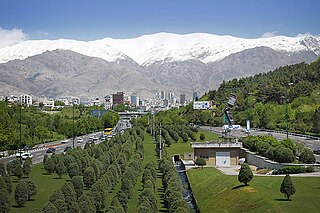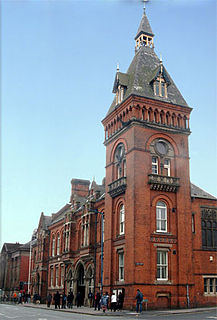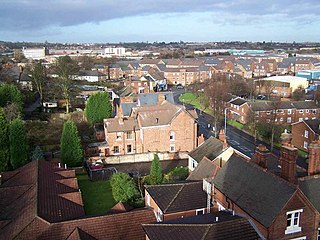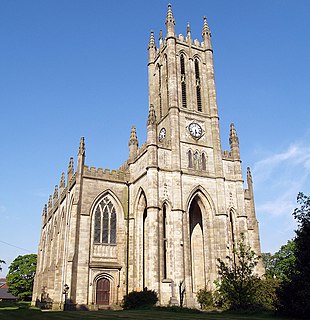Related Research Articles

A green belt is a policy and land-use zone designation used in land-use planning to retain areas of largely undeveloped, wild, or agricultural land surrounding or neighboring urban areas. Similar concepts are greenways or green wedges, which have a linear character and may run through an urban area instead of around it. In essence, a green belt is an invisible line designating a border around a certain area, preventing development of the area and allowing wildlife to return and be established.

West Bromwich is a market town in the borough of Sandwell, West Midlands, England. Historically part of Staffordshire, it is 6.4 miles (10.3 km) north-west of Birmingham. West Bromwich is part of the area known as the Black Country, in terms of geography, culture and dialect. West Bromwich had a population of almost 78,000 in 2018.

Tipton is an industrial town in the West Midlands in England with a population of around 38,777 at the 2011 UK Census. It is located 16 kilometres (9.9 mi) northwest of Birmingham.

Urban renewal is a program of land redevelopment often used to address urban decay in cities. Urban renewal involves the clearing out of blighted areas in inner cities to clear out slums and create opportunities for higher class housing, businesses, and other developments.

Whitefield is a town in the Metropolitan Borough of Bury, Greater Manchester, England. It lies on undulating ground above the Irwell Valley, along the south bank of the River Irwell, 3 miles (4.8 km) south-southeast of Bury, and 4.9 miles (7.9 km) to the north-northwest of the city of Manchester. Prestwich and the M60 motorway lie just to the south.

Cranebrook is a suburb of Greater Western Sydney, in the state of New South Wales, Australia, and is located 50 km radially WNW of the Sydney central business district, in the local government area of the City of Penrith. Cranebrook is part of the Greater Western Sydney region.

The United Kingdom has a network of roads, of varied quality and capacity, totalling about 262,300 miles (422,100 km). Road distances are shown in miles or yards and UK speed limits are indicated in miles per hour (mph) or by the use of the national speed limit (NSL) symbol. Some vehicle categories have various lower maximum limits enforced by speed limiters. A unified numbering system is in place for Great Britain, whilst in Northern Ireland, there is no available explanation for the allocation of road numbers.

Moulsecoomb is a suburb of Brighton, England, on the northeast side around Lewes Road, between Coldean and Bevendean, 2+1⁄4 miles (3.6 km) north of the seafront. The eastern edge adjoins Falmer Hill on the South Downs. It is often divided into smaller sections on maps: North Moulsecoomb, East Moulsecoomb and South Moulsecoomb.

The Merseyside Development Corporation was a central government-appointed Development Corporation set up in 1981 by Margaret Thatcher's government to regenerate the Mersey docks of Liverpool, Bootle, Wallasey and Birkenhead. It was one of two Development Corporations to be set up in 1981, the other being the London Docklands Development Corporation, which also focused on disused docklands.
The Black Country New Road is a major road which runs through the West Midlands of England.

The Leeds Development Corporation was established in 1988 to develop South Central Leeds and the Kirkstall Valley. Its flagship developments included the Royal Armouries Museum at Clarence Dock and the Hunslet Green housing development. During its lifetime 4.1 million sq.ft. of non-housing development and 571 housing units were built. Around 9,066 new jobs were created and some £357m of private finance was leveraged in. Around 168 acres (0.68 km2) of derelict land was reclaimed and 7.2 miles (11.6 km) of new road and footpaths put in place.

The Tyne and Wear Development Corporation (TWDC) was established in 1987 to develop land on the banks of the River Tyne and the River Wear in England. Its flagship developments included the regeneration of the East Quayside in Newcastle, Royal Quays in North Tyneside and St Peter's in Sunderland. During its lifetime 10,700,000 square feet (990,000 m2) of non-housing development and 4,550 housing units were built. Around 33,707 new jobs were created and some £1,115m of private finance was leveraged in. Circa 1,287 acres (521 ha) of derelict land was reclaimed and 24 miles (39 km) of new road and footpaths put in place. The Chairman was Sir Paul Nicholson and the Chief Executive was Alastair Balls. It was dissolved in 1998.
The Trafford Park Development Corporation was established in 1987 to develop land in Trafford and Salford. Its flagship developments included the Quay West office development at Wharfside, Trafford Park Village and Northbank Industrial Park. During its lifetime 8.3m sq.ft. of non-housing development and 461 housing units were built. Around 25,618 new jobs were created and some £1,560 million of private finance was leveraged in. About 497 acres (2.01 km2) of derelict land was reclaimed and 27 miles (43 km) of new road and footpaths put in place. The chairman was Bill Morgan and the chief executive was Mike Shields. It was dissolved in 1998.

The Teesside Development Corporation was a government-backed development corporation that was established in 1987 to fund and manage regeneration projects in the former county of Cleveland in North East England.
The Birmingham Heartlands Development Corporation was established in 1992 to develop 9.5 square kilometres of land in the East of Birmingham.

The Plymouth Development Corporation was an urban development corporation established in Plymouth, Devon, England by the UK Government on 1 April 1993 to "secure the physical, environmental, economic and social regeneration" of surplus parts of the Ministry of Defence's estate and some adjoining land. It had an indicative budget of £45 million and a lifetime of five years. Although subject to criticism for financial irregularities, it laid the foundation for improvements that continued for several years after it was wound up.
The Bristol Development Corporation was established in 1989 to develop parts of eastern Bristol, England. Its flagship developments included the Bristol Spine Road. During its lifetime 1.3m sq.ft. of non-housing development and 676 housing units were built. Around 4,825 jobs were created and some £235m of private finance was leveraged in. Circa 180 acres (0.73 km2) of derelict land was reclaimed and 4.1 miles (6.6 km) of new road and footpaths put in place.

The Central Manchester Development Corporation was established in 1988 to develop parts of eastern Manchester. Its flagship developments included the Bridgewater Hall concert auditorium.

Broomhouse is a residential area in Glasgow, Scotland. It is about 6 miles (10 km) east of the city centre. Historically a small mining village and later the site of the Glasgow Zoo, in the early 21st century it grew substantially as an affluent commuter suburb.
References
- ↑ Michael C. R. Davies (1991). Land Reclamation: An End to Dereliction?. Taylor & Francis. ISBN 1-85166-658-3.
- ↑ National Audit Office report dated 27 February 2002.
- ↑ "The Urban Development Corporations in England (Dissolution) Order 1998". www.legislation.gov.uk. Retrieved 28 August 2018.